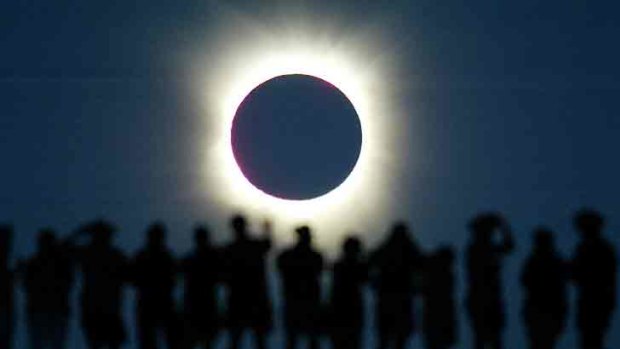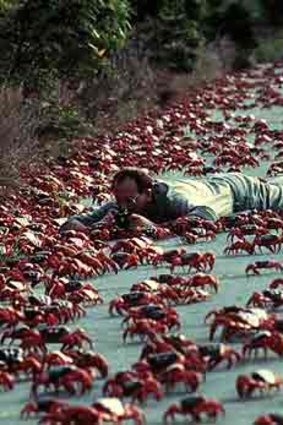This was published 13 years ago
The world's most amazing natural phenomena

Tourists watch the sun being blocked by the moon during a solar eclipse in the Australian outback town of Lyndhurst, about 700kms north of Adelaide, in late 2002.Credit: Reuters
Nature is always amazing, but sometimes it pulls a really freakish rabbit out of a hat. Here's where to catch the strangest of the strange natural sights, taken from Lonely Planet's new book, 1000 Ultimate Sights.
CATATUMBO LIGHTNING, VENEZUELA
Centred on the mouth of the Río Catatumbo at Lago de Maracaibo, this strange phenomenon consists of frequent flashes of lightning with no accompanying thunder. The eerie, silent electrical storm, referred to as Catatumbo Lightning, can be so strong and constant (150 to 200 flashes per minute) that it's possible to read by it at night, and it's said to be the world's largest single generator of ozone. Various hypotheses have been put forth to explain the lightning, but the theory that stands out is that cold winds descending from the Andes clash with hot, humid air evaporating from the lake, producing the ionisation of air particles.
On average, storms occur on 150 nights each year and are at their fiercest at times of high humidity.
PITCH LAKE, TRINIDAD & TOBAGO
Once thought of as a punishment from the gods, this bubbling lake of pitch is perhaps Trinidad's greatest oddity. Birdwatchers will find it of interest as well for the species it attracts. The 40-hectare expanse of asphalt is 90 metres deep at its centre, where hot bitumen is continuously replenished from a subterranean fault. The lake, one of only three asphalt lakes in the world, has the single largest supply of natural bitumen, and as much as 300 tonnes are extracted daily. The surface looks like a clay tennis court covered with wrinkled elephant-like skin, and during the rainy season you can sit in its warm sulphurous pools.

Brazilian Picuruta Salazar surfs a wave on the Amazon River in Amapa in northeastern Brazil in 2003, riding the longest wave on earth.Credit: Reuters
The lake is 22km southwest of San Fernando near the town of La Brea; guided tours are available – high heels are not recommended.
LAMBERT GLACIER, ANTARCTICA
In a world of shrinking glaciers it's nice to know there's always Lambert Glacier. The world's longest glacier drains about 8 per cent of the Antarctic ice sheet and is up to 400km long and 200km wide at the point where it reaches the Amery Ice Shelf. The shelf itself is a seaward extension of the Lambert, and is a source for one of the rarest and most beautiful sights in the natural world: bottle-green icebergs, resulting from the high content of organic material inside the ice.

The annual migration of the red land crab to the sea is a world-renowned spectacle.Credit: Greg Miles
Getting to this extremely isolated part of Antarctica requires a long voyage and isn't cheap, so it is visited only rarely – just one or two tourist ships a year come here.
DON JUAN POND, ANTARCTICA
Antarctica's Dry Valleys are remarkable enough in what is already an impressive continent: huge, desolate spaces covering 3000-square-kilometre without snow or ice. Here, algae, bacteria and fungi, some of it thought to be 200,000 years old, have been found growing inside rocks. The Onyx River flows inland from the coast and there's a lake, Lake Vanda, that is a balmy 25°C at its bottom. There's also Don Juan Pond, which is only 10 centimetres deep but the most saline body of water on the planet, 14 times saltier than the ocean. It is so salty, in fact, that this shallow pond never freezes, even at temperatures of -55°C.
Vanda Station, 14km east of Don Juan Pond, is the closest settlement. Don't expect bright lights – it's only staffed temporarily by a small band of researchers.
RED LAND CRABS, AUSTRALIA
For most of the year you'll see little of the red land crabs of Australia's Christmas Island. They live in shady sites inside the forest that covers much of the island's plateau. Then, suddenly, at the beginning of the wet season, in around October or November, more than 100 million enormous red crabs suddenly emerge, breaking out of the forest like escapees, climbing down cliff faces and – more dangerously – crossing roads. All this so the female crabs can release their eggs into the Indian Ocean at precisely the turn of the high tide during the moon's last quarter.
Schedules are irregular, but you can fly to Christmas Island from Perth (www.virginblue.com.au) or Kuala Lumpur (www.malaysiaairlines.com).
SOLAR ECLIPSE, AUSTRALIA
For millennia, eclipses have fascinated those who witness them; Homer wrote about a total eclipse in the ancient Greek epic The Odyssey. Eclipses are some of nature's most awe-inspiring spectacles, and great excuse for a party. Solar eclipses occur a couple of times a year, but the total blocking of the sun is only visible from a small part of the earth's surface. A total solar eclipse will take place on 13/14 November 2012, and Cairns, in far north Queensland, will be one of the best places on earth to witness the incredible event.
Make your way to festival events being planned in Cairns and surrounding regions: details can be found at www.solareclipse2012.com.
RAIN OF FISH, HONDURAS
Virtually every year in June or July, dark storm clouds gather over the small town of Yoro and unleash a tremendous summer rainstorm. In the downpour appear thousands of silvery fish, flopping on the ground. Locals believe the phenomenon is nothing less than an act of god. They trace its origin to a 19th-century Spanish missionary who prayed for a miracle to feed the people. Biologists say it can be explained scientifically, but have yet to provide any conclusive evidence. Either way you look at it, it's an occasion for a party: the annual Festival de la Lluvia de Peces includes parades, music and lots of fried fish.
Base yourself in bustling San Pedro Sula, with its great entertainment and nightlife; from here it's a three-hour bus ride to Yoro.
MORNING GLORY CLOUDS, AUSTRALIA
Be up bright and early at dawn for the chance to watch a meteorological wonder roll into northern Australia's Gulf of Carpentaria. The Morning Glory is a tubular cloud (or series of clouds) up to 1000km in length, that rolls across the sky in the early morning, pushing great updrafts ahead of it. It's these updrafts that have made it one of the great places for gliding and hang-gliding adventures. First soared in 1989, Morning Glories have carried gliders for more than 700km and up to six hours.
The Morning Glories usually occur from September to late October. Burketown in northern Queensland makes a good base for viewing.
POROROCA TIDAL BORE, AMAZON RIVER, BRAZIL
At the mouth of the Amazon, the Atlantic's tide occasionally – when the moon is right – gets the better of the outpouring river. The result: the longest tidal wave on earth. In the predawn light you'll hear the monkeys screeching and a distant dull roar before you see the wave – all 4 metres of it charging upstream, taking all manner of shoreside debris, and some very intrepid surfers, along with it. The surfing record to date is a 12.5km ride lasting 37 minutes. You'll be able to enjoy the spectacle at the annual National Pororoca Surfing Championships in São Domingos do Capim in March.
The pororoca occurs twice a day, three days a month; waves are biggest in February and March.
RACETRACK, CALIFORNIA, USA
Who wouldn't expect a few oddities in a place like California's aptly named Death Valley? Prime among them is the mystery of the 'racing' stones in the valley's remote north. These large, flat stones, some of which weigh as much as 180kg, have 'raced' across the earth, leaving grooves in the dry, cracked lake bed behind them. Nobody has actually ever seen any of the rocks move, and science's best guess is they've been blown across at times when the lake bed is slippery from rain or frost.
You can camp in Death Valley, but with furnace-like temperatures you might prefer an air-conditioned lodge (www.nps.gov/deva).
This is an extract from Lonely Planet's 1000 Ultimate Sights © Lonely Planet 2011. RRP: $34.99. lonelyplanet.com
Sign up for the Traveller Deals newsletter
Get exclusive travel deals delivered straight to your inbox. Sign up now.